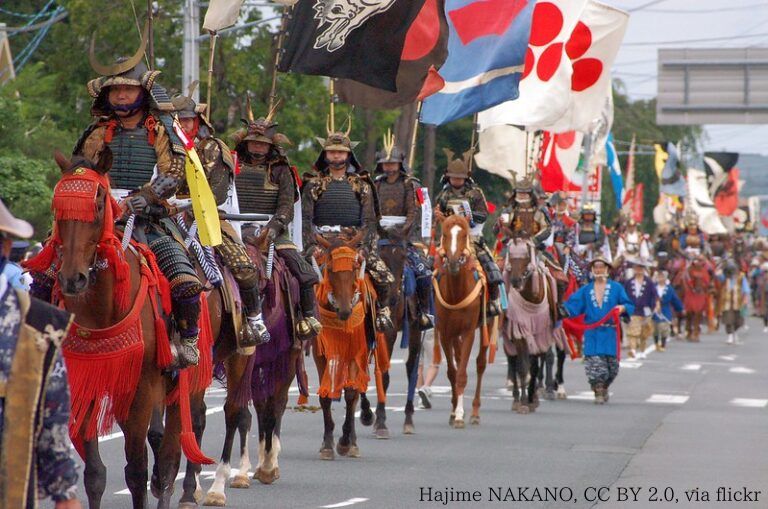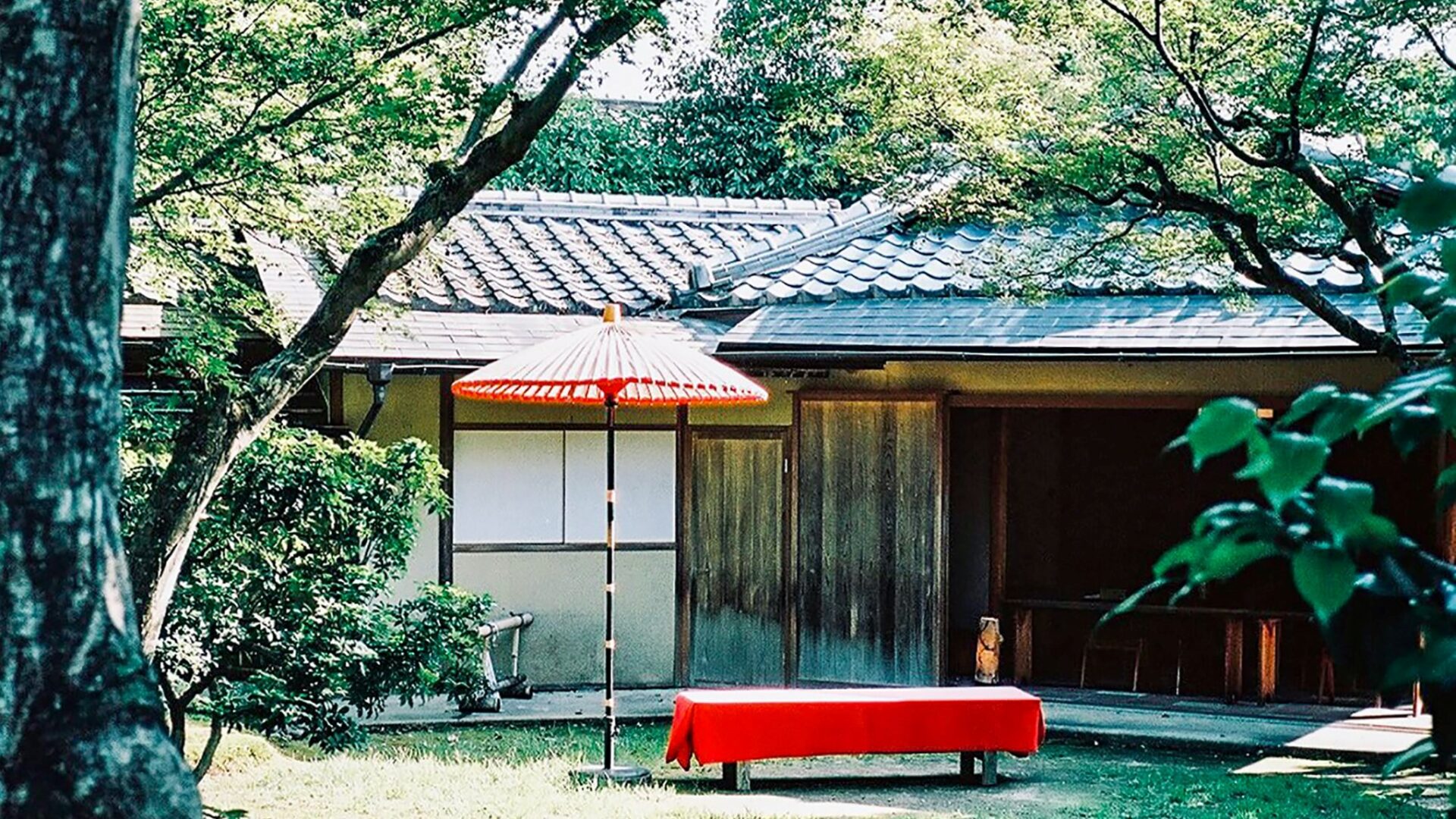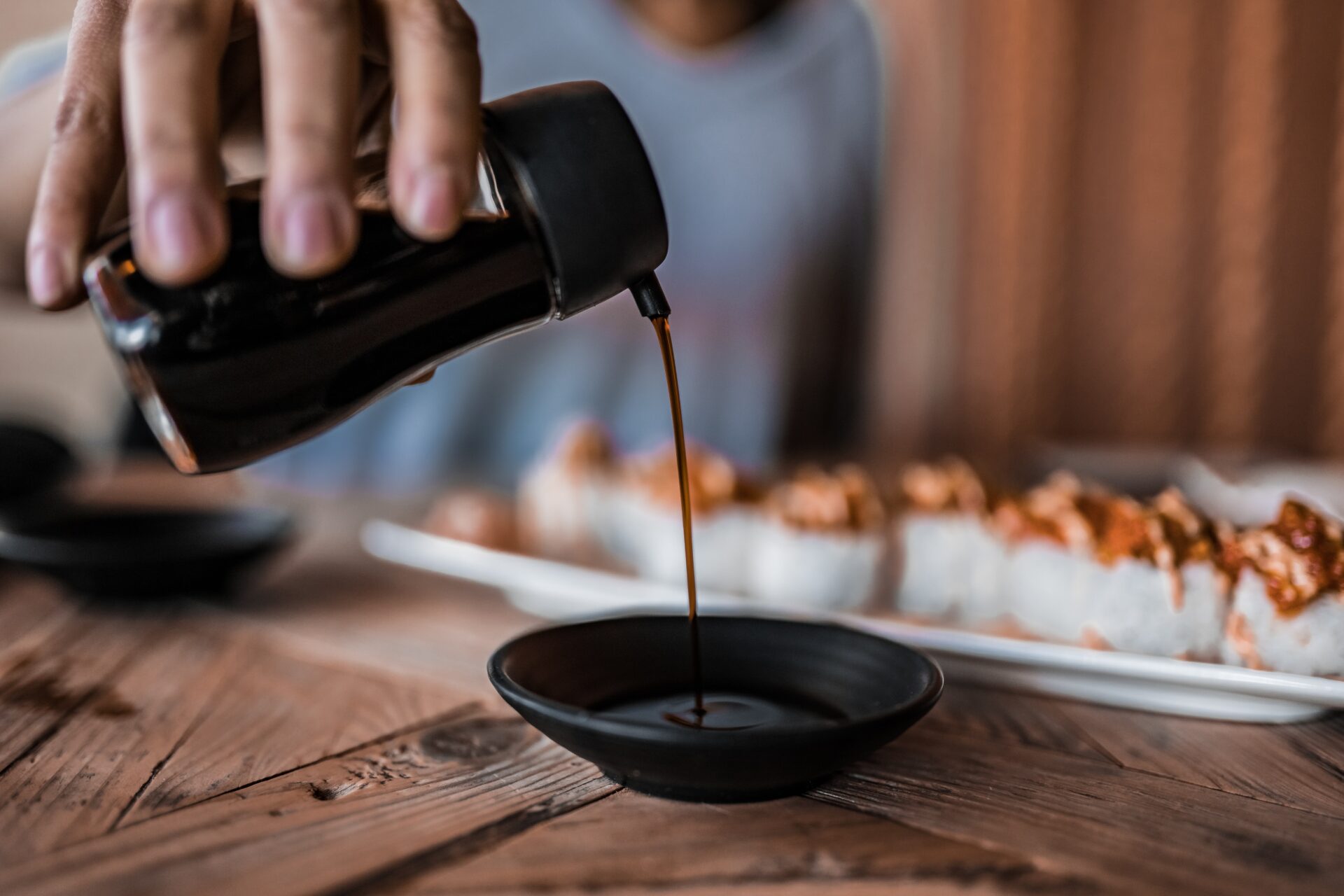Soma Nomaoi is a major event in Hamadori, Fukushima Prefecture. Designated as an Important Intangible Folk Cultural Asset of the country, the festival is so popular that a total of approximately 163,000 spectators visited the event in 2019. Due to the spread of COVID-19, most of the Soma Nomaoi events were canceled in 2020 and 2021. But finally, this year in 2022, for the first time in three years, Soma Nomaoi will be held again! In this article, we will introduce you to the Soma Nomaoi festival.
What is Soma Nomaoi?
Soma Nomaoi is a traditional event that has been held in Minamisoma and Soma City of Fukushima Prefecture for more than 1,000 years. About 400 mounted warriors, wearing armor, swords at their waists, and flag-designated weapons on their backs, gallop across the fields.
It is said that Soma Nomaoi began when the ancestors of the Nakamura clan of Soma released horses as if they were enemy soldiers and used them as a part of their military. The captured horses were then dedicated to Myoken, the deity of the clan, as sacred horses.
However, the event was interrupted when the Nakamura clan was wiped out as history progressed and all wild horses had been taken in. Six years later, a joint ceremony was held at Soma Nakamura Shrine, Soma Ota Shrine, and Soma Odaka Shrine, which eventually became what the current Soma Nomaoi is today. Since then, the festival has been held as a ritual dedicated to wild horses and to praying for peace and tranquility in the Soma area.
Festival Details
Festival Dates
The Soma Nomaoi Festival is held on the last Saturday, Sunday, and Monday of July every year.
In 2022, it will be held on July 23 (Sat), 24 (Sun), and 25 (Mon).
Venue for the Shutsujin Shiki (Opening Ceremony)
The Shutsujin Shiki(Opening Ceremony)will be held at Soma Nakamura Shrine, Soma Ota Shrine, and Soma Odaka Shrine of the three Myokensha shrines in Soma.
Soma Nakamura Shrine
At Soma Nakamura Shrine, the general’s Shutsujin Shiki (Opening Ceremony) is held. There are horses on the railing of the stairs of the shrine, as well as many horses and guardian horses at the entrance. There are also real horses at the entrance of the shrine! It is said that many horse racing fans visit the shrine.
Soma Ota Shrine
At Soma Ota Shrine, the Nakanogo forces hold their opening ceremony. It is believed to be the place where the Soma clan first settled when they made their way there during the Kamakura period (1185-1333). At the shrine, there is a white horse figurine to which visitors can dedicate their wishes and other horse-related requests. The shrine also has a horse sculpture in the main shrine building, so be sure not to miss this too.
Soma Odaka Shrine
The Odakago Shutsujin Shiki(Opening Ceremony) is held at the Soma Odaka Shrine. This shrine is believed to be the horse guardian deity. When the Oshu Soma clan was living at the castle, it was used as a base for warfare. We also highly recommend checking out the view of the city from the hill.
Main Venue
Hibarigahara Saijouchi(Festival Site) is located in Haramachi-ku, Minamisoma City.
・Approximately 10 minutes by car from Haranomachi Station on the Joban Line
・Approximately 15 minutes by car from Joban highway Minamisoma I.C.
*There is a shuttle bus service that operates from Haranomachi Station during the second day of the festival (main festival).
Soma Nomaoi Schedule
The schedule of Soma Nomaoi varies by district (Soma City, Kashima-ku, Haramachi-ku, and Odaka-ku in Minamisoma City).
Here are some of the highlights of the three-day Soma Nomaoi Festival!
Day 1: Opening Ceremony and Yoinori Horse Race

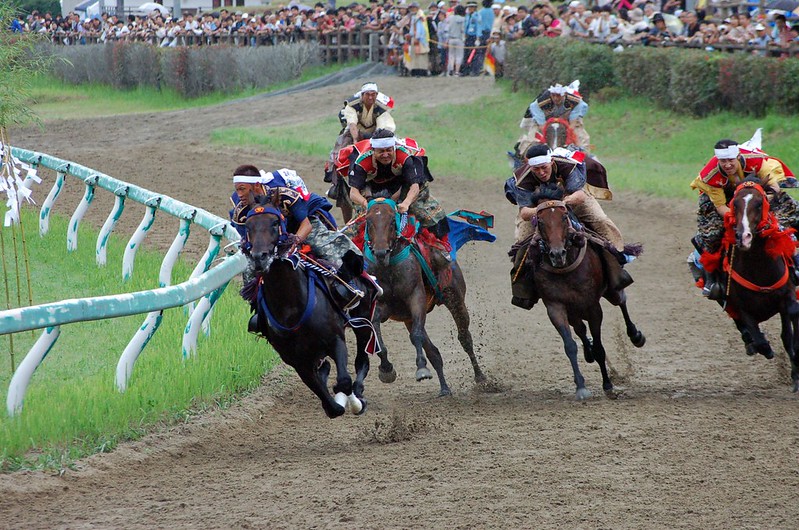
On the first day, there will be a Shutsujin Shiki(Opening Ceremony) at each of the three shrines, a general welcoming where you can see a mounted warrior’s speech, and a Yoinori Horse Race, where young warriors dressed in jin haori (a ceremonial robe worn by a samurai) will run.
The Shutsujin Shiki(Opening Ceremony) will be held at each of the three shrines: Soma Nakamura Shrine, Soma Ota Shrine, and Soma Odaka Shrine. The Shutsujin Shiki(Opening Ceremony) held at Soma Nakamura Shrine, which is designated as an Important Cultural Property of Japan, is particularly amazing, as the general commander is present.
When the riders are ready to start the parade, they set out with the sound of a conch shell and make a circuit of the city, heading for the Kitago Jinya (camp) in Kashima-ku, Minamisoma City. Although it is not widely known, no other Kitago cavalrymen are allowed to enter the Kitago camp without permission. After making a verbal statement at the entrance to the cavalryman in charge of guarding the camp, they must receive permission to enter. Please check out the scene of the cavalrymen receiving permission, it is truly an amazing sight to see. After the welcoming ceremony, head over to the Hibarigahara Saijouchi(Festival Site).
At the Hibarigahara Saijouchi(Festival Site), the Yoinori horse race will be held. The sight of young warriors dressed in jinba-robes running around a 1,000 meter track is quite a sight to behold.
Day 2: Main Festival (O-gyoretsu (parade), Armored Horse Race, and Battle for the sacred flag)
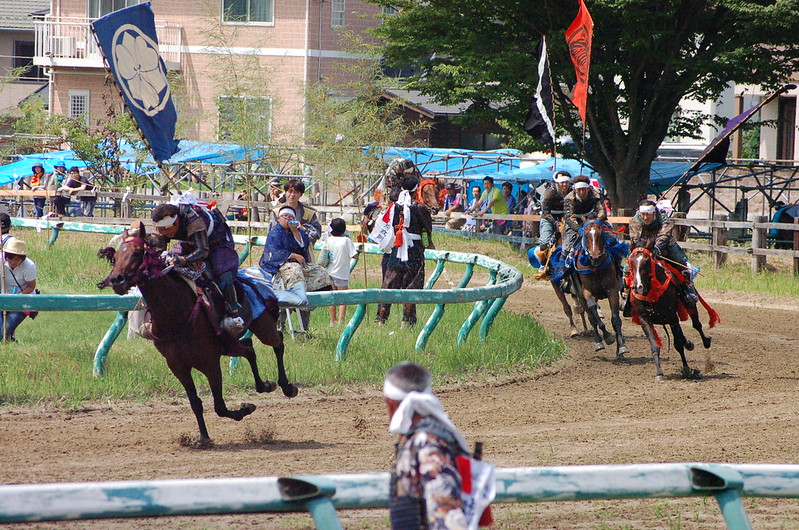
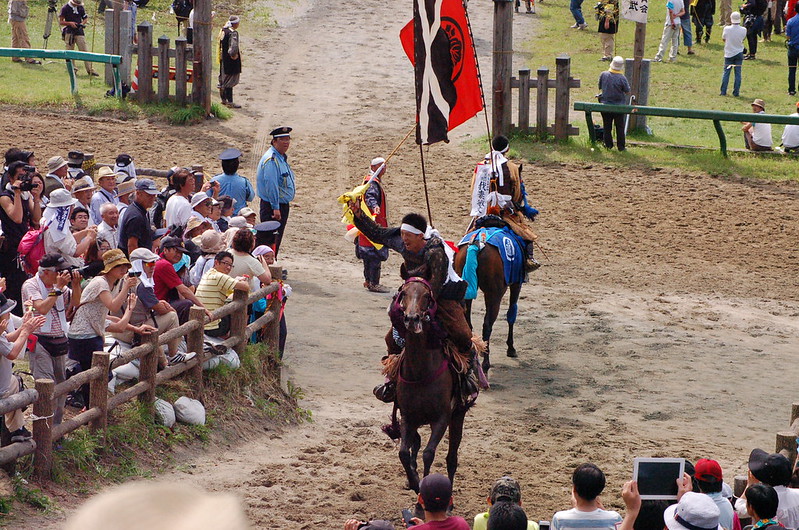
On the second day of the main festival, there is a O-gyoretsu(parade) in which about 400 mounted warriors march through the city with portable shrines weighing about 3 kg, Kacchu Keiba(Armored Horse Race) in which warriors run through the city with flags and ornaments fluttering, and Shinki Soudatsusen(Battle for the sacred flag) in which the warriors fight for the sacred flag that is flown high in the sky.
The O-gyoretsu(parade) begins with the signal for the start of the Sanbanro and Jindaiko (drummers). The O-gyoretsu(parade) starts from Ogawa Bridge on Nomaoi Street and goes in the direction of the Hibarigahara Festival site, which is about 3km away. When watching the O-gyoretsu(parade), please note that you should not look down on the parade from above. Even if you are on the second floor of a building, come out to the roadside to watch the O-gyoretsu(parade), it is frowned upon as you will be looking down on the gods.
The Kacchu Keiba(Armored Horse Race) is a competition in which mounted warriors with flags pointing to their backs run 1,000 meters around a circuit. It is stunning listening to the sound of the flags flapping in the wind and the hoof beats of the horses as they gallop past you.
In the Shinki Soudatsusen(Battle for the sacred flags), mounted warriors in armor fight for the sacred flags that fly in the sky. The sacred flags are stuffed into a ball of fireworks, and when the fireworks are lit off, it gracefully falls as if dancing in the sky. Hundreds of mounted warriors swarm to the landing site to grab the flags. The warriors who grab the sacred flags run up the hill and report to the main camp.
Day 3 (Final Day): Nomakake
On the third day, Nomakake will be held at Soma Odaka Shrine. The Nomakake is said to be the only ritual that retains vestiges of the old days. First, a mounted warrior chases a horse into the premises of Odaka Shrine. Then, the horse is marked with a pole containing sacred water. After that, the horses are captured with bare hands and the first horse caught is dedicated to the deity.
Soma Nomaoi Schedule/tickets 2022
So far, no information has been announced on how or what tickets will be sold for the 2022 festival. Please refer to the following list for the types of tickets and prices for past years from the Soma Nomaoi website.
The Hibarigahara Saijouchi(Festival Site) where the The Kacchu Keiba(Armored Horse Race) and the Shinki Soudatsusen(Battle for the sacred flag) will be held, is not accessible without a ticket. Tickets are also available for the parade spectator seats, where you can sit and watch the parade.
Reserved seats for groups (20 people or more)
Event: The Kacchu Keiba(Armored Horse Race) and the Shinki Soudatsusen(Battle for the sacred flag)
Venue: Hibarigahara Festival site
Fee: 1,500 yen/person
Admission ticket ( on the day of the event )
Event: The Kacchu Keiba(Armored Horse Race) and the Shinki Soudatsusen(Battle for the sacred flag)
Venue: Hibarigahara Festival site
Fee: 1,000 yen/person (high school students and older)
Seats for the parade (4 or more people)
Event: Parade
Location: Nomaoi Street
Fee: 2,500 yen/person
Photo Permit
Event: The Kacchu Keiba(Armored Horse Race) and the Shinki Soudatsusen(Battle for the sacred flag)
Location: Hibarigahara Festival site
Fee: 4,000 yen/person
Eligibility for Participation
Skill on horseback is required, as well as affiliation with a horsemen’s association. You do not need to be a local to be a participant in the festival. Riding clubs and university equestrian clubs in the Kanto region also partake in Soma Nomaoi. Furthermore, about 90% of the horses ridden in the festival are former racehorses. Some people borrow them from other districts, so even if you don’t have your own horse, you can still participate!
For those who want to participate for the first time
A new program is now available for those who would like to participate in Soma Nomaoi. In order to encourage more people to participate in this traditional festival, in 2022 Minamisoma City started an initiative called the “First-Time Participant Sponsor System” which will provide helpful support to make it easier for first-timers to participate in Soma Nomaoi.
Support Program Details
1. Intermediary to the Kiba-kai (horse riders’ association)
In order to participate in Soma Nomaoi, it is necessary to join the Kiba‐kai. The city will act as an intermediary to introduce you to the Kiba-kai.
2. Assistance in preparation for participation
A veteran member of the Kiba-kai, called a “Sponsor” will help you with the arrangements for horses and the procedures for participating in the event.
Armor and Harness Workshop Abe
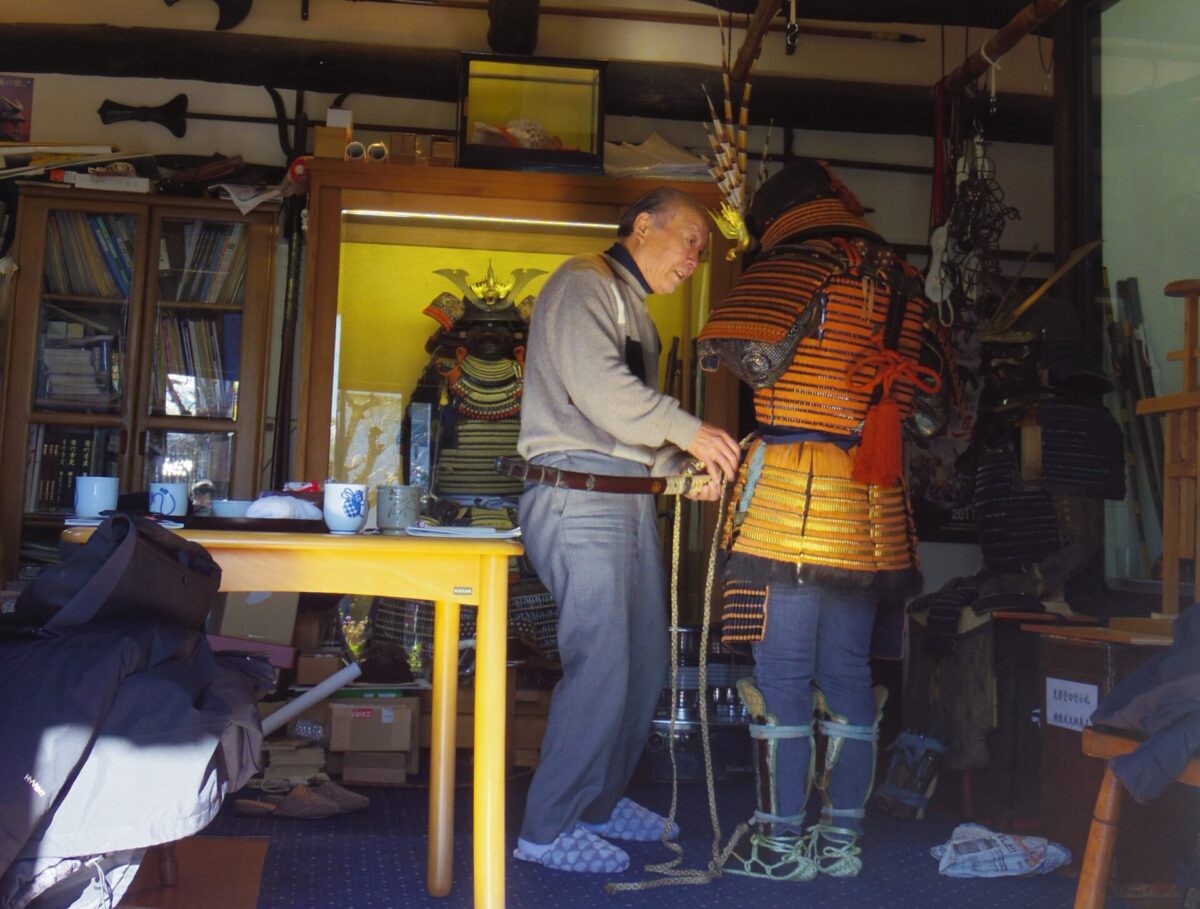
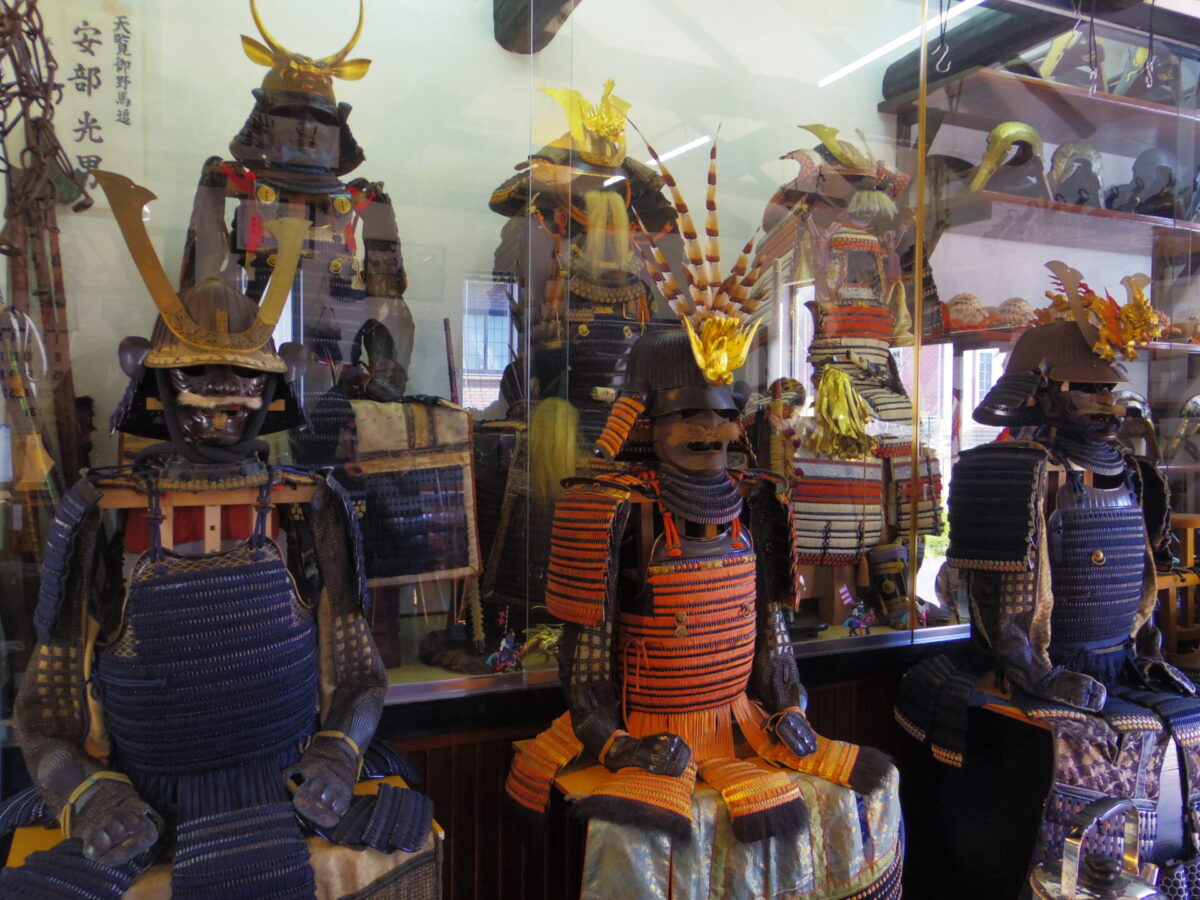
The armor used in Soma Nomaoi often requires repair and other maintenance work. Materials used for armor, such as leather, wood, and metal inevitably deteriorate over time. The Armor and Harness Workshop Abe, located in Minamisoma, repairs and sells old-style harnesses and armor. The shop takes on the repair and renewal of armor used by contestants of the Soma Nomaoi. In the store, you can see various Kabuto (helmets) and swords. Many people have had their armor arranged here in the past, so if you call in advance and make a request, they may be able to help you out as well.
That concludes our short introduction to Soma Nomaoi. Which event in particular would you like to see? Watching the events on the internet or on video just isn’t quite the same as seeing them in person, so we highly recommend seeing them firsthand in Hamadori if you have the chance!
If you decide to go to see Soma Nomaoi in July, why not make the most of your visit and also check out the remains of the 3.11 disaster and the devastated towns in Hamadori?
Follow us on Instagram, Facebook and Twitter for more travel inspiration. Or tag us to get featured!
Happy traveling!
Fukushima Daiichi Nuclear Power Plant Tour
Other articles you might be interested in

Asahi Eda is from Naka‐dori, Fukushima Prefecture. Her favorite foods from Fukushima are braised pork noodles from Tora Shokudo and Shimiten from Konohata.
This post may contain some affiliate links. When you click through and make a purchase we may receive some commission, at no extra costs to you.
